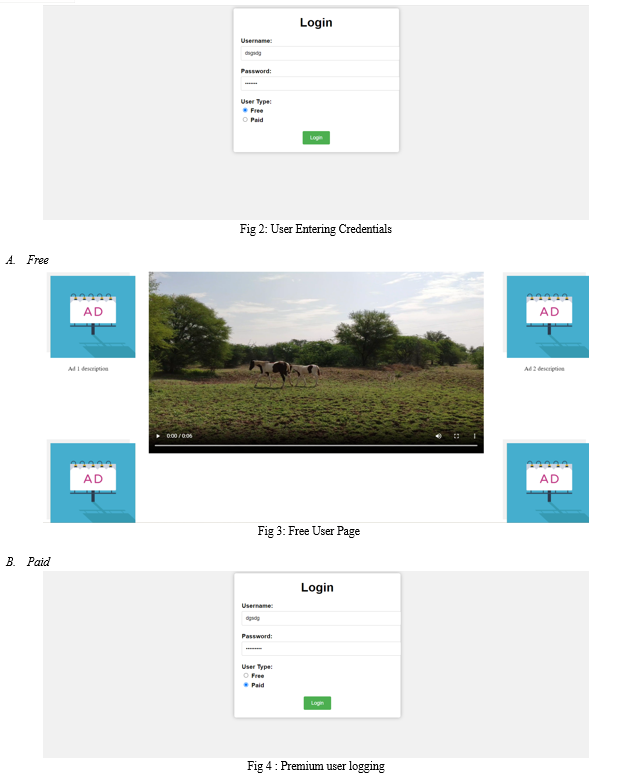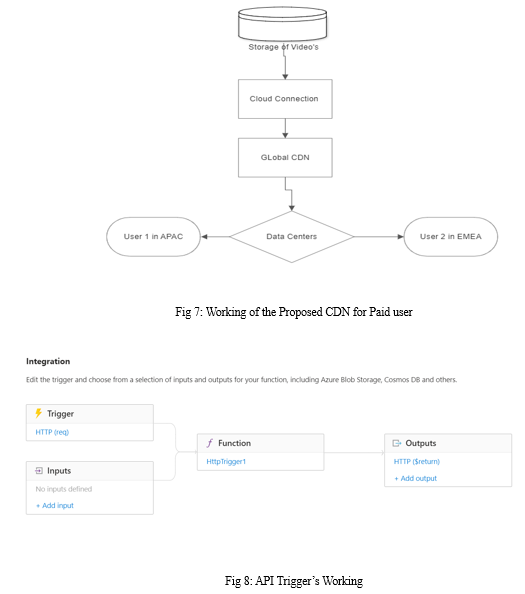Ijraset Journal For Research in Applied Science and Engineering Technology
- Home / Ijraset
- On This Page
- Abstract
- Introduction
- Conclusion
- References
- Copyright
Dynamic User Routing, Paid and Free Users, Web applications, Content Delivery Network (CDN)
Authors: Abhishek Varma G V S, Akshay Varma G V N
DOI Link: https://doi.org/10.22214/ijraset.2023.54654
Certificate: View Certificate
Abstract
This research paper introduces a novel approach for efficient routing between paid and free users in web applications by harnessing the capabilities of a Content Delivery Network (CDN). The primary objective of this study is to optimize user experience and resource allocation based on user type, aiming to deliver personalized content while maximizing resource utilization. The proposed routing mechanism dynamically directs users to the appropriate pages or content based on their subscription status, leveraging the integration of a CDN into the web application architecture. The paper thoroughly explores the implementation details, emphasizing the seamless interaction between the CDN and user authentication mechanisms, and investigates the routing algorithms employed to intelligently determine the most suitable content delivery path for each user type. Through comprehensive experimentation and evaluation, the research demonstrates the efficiency and scalability of the proposed approach. Various user scenarios are considered, and factors such as response time, resource utilization, and content availability are evaluated. The experimental results showcase the significant enhancement of the overall user experience achieved through the dynamic user routing mechanism, providing tailored content delivery while effectively managing resource allocation. The findings of this research contribute to the field of web application development, particularly in managing different user types and delivering personalized content. By effectively leveraging CDNs and implementing dynamic routing strategies, web applications can optimize user satisfaction, ensure efficient resource utilization, and accommodate varying user subscription models. This research offers valuable insights and practical implications for designing and implementing user-centric web applications that deliver customized experiences and efficiently allocate resources based on user types. The paper delves into the implementation details, highlighting the key components and functionalities of the proposed solution. It explores the integration of the CDN into the web application architecture, emphasizing the seamless interaction between the CDN and user authentication mechanisms. Additionally, it investigates the routing algorithms employed to intelligently determine the appropriate content delivery path for each user type.
Introduction
I. INTRODUCTION
In today's digital era, web applications have become an essential part of our daily lives, offering a wide range of services and content. As the popularity of online platforms continues to soar, it has become increasingly important for web developers to meet the diverse needs and preferences of different user categories. A crucial aspect of this customization involves effectively distinguishing between paid and free users and providing them with personalized experiences. The user routing mechanism plays a pivotal role in optimizing user satisfaction and resource allocation within web applications. Traditional web applications have predominantly relied on static routing mechanisms, where all users are directed to the same set of pages or content, regardless of their subscription status. However, this approach often falls short in meeting the diverse requirements of paid and free users. Paid users, who contribute financially to the platform, expect exclusive content, enhanced features, and a seamless user experience. Conversely, free users may have access to limited features and encounter advertisements as a means of revenue generation for the platform.
To address these challenges and improve user experience, this research paper introduces a dynamic user routing approach using a Content Delivery Network (CDN)[1]. CDNs have gained widespread popularity due to their ability to distribute content across multiple servers worldwide, resulting in faster delivery and improved scalability. By leveraging the capabilities of a CDN, the proposed routing mechanism intelligently directs users to the appropriate pages or content based on their subscription status, thereby optimizing the user experience and resource allocation. The implementation of the dynamic user routing approach encompasses several key components. Firstly, the integration of the CDN into the web application architecture facilitates seamless interaction between the CDN and the user authentication mechanisms. This integration ensures that user types, namely paid and free, are accurately identified and authenticated. Secondly, routing algorithms are employed to determine the most suitable content delivery path for each user type. These algorithms consider various factors such as content availability, user preferences, and server load, thereby ensuring efficient resource utilization and personalized content delivery.
The proposed dynamic user routing approach offers a multitude of benefits. Paid users receive a premium experience with exclusive content, enhanced features, and reduced exposure to advertisements. This personalized experience fosters higher user engagement, increased satisfaction, and potentially encourages user retention. Free users, on the other hand, have access to a tailored set of features and content, ensuring a satisfactory user experience while supporting the revenue generation model of the platform.
However, the implementation of dynamic user routing using a CDN also presents certain challenges. One significant challenge is ensuring seamless coordination between the CDN and the web application's authentication systems to accurately identify and authenticate users. Additionally, the dynamic routing algorithms must be robust and scalable to handle large user bases and varying traffic patterns effectively[2]. Addressing these challenges requires careful consideration and thorough testing of the proposed solution.
In this research paper, we delve into the implementation details of the dynamic user routing approach using a CDN. We present the architecture, integration process, and routing algorithms employed. Furthermore, we evaluate the effectiveness of the proposed approach through comprehensive experimentation, including performance metrics such as response time, resource utilization, and user satisfaction. The results of the experimental evaluation showcase the efficiency and scalability of the dynamic user routing mechanism, emphasizing its potential to enhance user engagement and optimize resource allocation.
The findings of this research contribute to the field of web application development, particularly in the context of managing different user types and providing personalized content delivery. By effectively leveraging CDNs and implementing dynamic routing strategies, web applications can cater to the diverse needs of paid and free users, optimize user satisfaction, ensure efficient resource utilization, and accommodate varying user subscription models.
II. BACKGROUND AND RELATED WORK
In today's digital landscape, businesses and service providers often offer tiered pricing models, providing different features and functionalities to free and paid users. The User Type Selection project enables organizations to efficiently handle user requests by directing them to the appropriate backend systems. This segregation of user types enables businesses to offer personalized experiences, cater to specific needs, and manage resources effectively[3].
III. IMPLEMENTATION
The project employs a web-based interface created using HTML, CSS, and JavaScript. The webpage presents users with two buttons: one for selecting the free user type and the other for the paid user type. JavaScript, in conjunction with the jQuery library, is used to handle button clicks and initiate API requests accordingly. The backend implementation involves setting up Azure Function apps using Python, which receive the requests and process them based on the user type.



C. By using API’s
The Free User API endpoint handles requests from users who have chosen the free user type. This API can be customized to provide limited functionality, access to basic features, or a trial period for the services offered. Organizations can leverage this API to encourage users to experience the value of their offerings and potentially convert them into paid users in the future. Additionally, the Free User API allows businesses to gather data and insights about user behavior, which can inform decision-making and improve the overall service quality.
The Paid User API endpoint serves requests from users who have opted for a paid user type. This API provides access to premium features, enhanced functionalities, and dedicated support. By leveraging the Paid User API, organizations can deliver a superior user experience, cater to the needs of their paying customers, and maintain customer satisfaction and loyalty. The Paid User API may also facilitate secure transactions, confidential data handling, and other exclusive services[4].

Conclusion
In conclusion, the User Type Selection project presents a powerful solution for organizations seeking to enhance user experience, streamline resource allocation, and drive business growth. By offering a user-friendly interface that empowers individuals to choose between free and paid user types, this project ensures that users receive services and features that align with their specific needs and preferences. Through the utilization of distinct APIs for each user type, organizations can provide personalized experiences that cater to the unique requirements of free and paid users. This segmentation allows businesses to customize the functionalities and access levels provided to each user category, ensuring that free users receive a valuable taste of the offerings while paid users enjoy premium features, enhanced support, and exclusive services. One of the significant benefits of the User Type Selection project is the improved engagement it fosters. By tailoring services to individual user types, organizations can capture the attention and interest of their target audience more effectively. Free users have the opportunity to experience the value and benefits of the offerings, while paid users enjoy a heightened level of satisfaction and a sense of exclusivity. This, in turn, can lead to increased user loyalty, higher retention rates, and a greater willingness to convert from free to paid accounts. Furthermore, the project enables organizations to allocate resources more efficiently. By categorizing users into distinct segments, businesses can allocate appropriate resources, infrastructure, and support systems based on user type requirements. This optimization of resources not only enhances service quality and scalability but also allows organizations to control costs effectively and maximize operational efficiency[5]. Data-driven decision-making is another critical aspect facilitated by the User Type Selection project. By analyzing user behavior, preferences, and usage patterns, organizations can gain valuable insights that drive strategic decision-making, product enhancements, and targeted marketing campaigns. This data-driven approach empowers businesses to make informed choices, adapt their offerings to meet evolving user needs, and stay ahead of the competition. In conclusion, the User Type Selection project is a valuable tool for organizations seeking to deliver personalized experiences, efficiently allocate resources, and drive business growth. By empowering users to choose between free and paid user types and providing distinct APIs for each category, organizations can enhance user engagement, improve resource allocation, and make data-driven decisions. Ultimately, this project leads to heightened customer satisfaction, increased conversions, and long-term success in the competitive digital landscape.
References
[1] Aruna, Kumari B., and M. SREELATHA. \"A Block Chain Approach with Cloud Computing to Ensure Security for User profiles on Social Media Networks.\" NeuroQuantology 20.16 (2022): 4412. [2] B, S. N. ., S. R. . P, P. . Bethapudi, and S. P. R. . Reddy. “Malware Detection in Android Mobile Devices by Applying Swarm Intelligence Optimization and Machine Learning for API Calls”. International Journal of Intelligent Systems and Applications in Engineering, vol. 10, no. 3s, Dec. 2022, pp. 67-74, https://www.ijisae.org/index.php/IJISAE/article/view/2413. [3] Sambana, Bosubabu, et al. Internet of Things Enhanced Intelligent Guidance System for Smart Cities using Artificial Intelligence. No. 10080. EasyChair, 2023. [4] Rego, Paulo AL, et al. \"An openflow-based elastic solution for cloud-cdn video streaming service.\" 2015 IEEE Global Communications Conference (GLOBECOM). IEEE, 2015. [5] Hu, Han, et al. \"Community based effective social video contents placement in cloud centric CDN network.\" 2014 IEEE International Conference on Multimedia and Expo (ICME). IEEE, 2014.
Copyright
Copyright © 2023 Abhishek Varma G V S, Akshay Varma G V N. This is an open access article distributed under the Creative Commons Attribution License, which permits unrestricted use, distribution, and reproduction in any medium, provided the original work is properly cited.

Download Paper
Paper Id : IJRASET54654
Publish Date : 2023-07-06
ISSN : 2321-9653
Publisher Name : IJRASET
DOI Link : Click Here
 Submit Paper Online
Submit Paper Online

